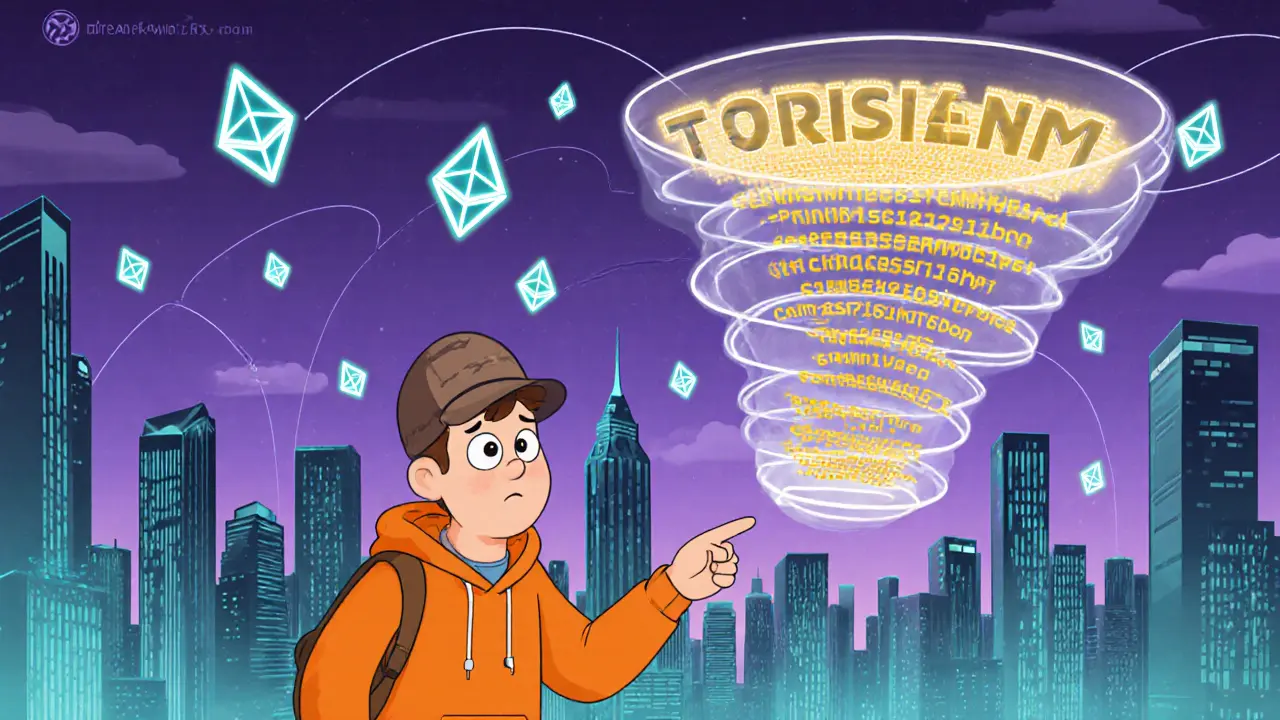 Sep, 29 2025
Sep, 29 2025
Tornado Cash Privacy Calculator
The probability of being linked to your transaction decreases as the anonymity set grows and time passes. Most users wait 30-50 days to maximize privacy.
When you look at a public blockchain like Ethereum, every move you make is visible to anyone with a block explorer. That transparency is great for trust, but it kills privacy. Tornado Cash tries to fix that by breaking the link between who sends money and who receives it. In the next few minutes you’ll learn exactly how the mixing process works, why zero‑knowledge proofs matter, what regulators have done, and whether the service is still a viable privacy tool.
What is Tornado Cash?
Tornado Cash is an open‑source, non‑custodial mixer protocol built on the Ethereum blockchain that uses cryptography to hide the origin of funds. It was launched in April 2019 by RomanSemenov, AlexeyPertsev, and RomanStorm. The protocol lives entirely in smart contracts, so no single person can shut it down or change the rules after deployment.
How the Three‑Step Mixing Process Works
- Deposit: You generate a secret “deposit note” on your computer, then send ETH (or a stablecoin) to the Tornado Cash pool contract. The note’s hash is the only thing you share with the contract - think of it as a receipt that only you can decode.
- Pool Aggregation: The contract groups deposits of the same size (0.1, 1, 10, or 100ETH, plus USDC, USDT, DAI, cDAI, and wBTC on other chains). As more users join, the anonymity set grows, making it harder to trace any single deposit.
- Withdrawal: Using your secret note, you create a zero‑knowledge proof that proves you own one of the pooled amounts without saying which one. A relayer can broadcast the withdraw transaction for a fee (0.05‑0.2%), keeping your withdrawal address totally separate from the deposit address.
The math behind step three is handled by zk‑SNARKs, a type of zero‑knowledge proof that lets you verify a statement without revealing any underlying data.
Zero‑Knowledge Proofs (zk‑SNARKs) - The Privacy Engine
zk‑SNARKs are cryptographic proofs that allow one party to prove knowledge of a secret without disclosing the secret itself. In Tornado Cash they confirm that a user owns a deposit note without linking that note to a specific address.
Because zk‑SNARKs are generated off‑chain, they add no extra gas cost to the contract itself. The proof is verified on‑chain, and if it checks out, the contract releases the funds to the caller.
Using Tornado Cash: From Wallet to Relayer
- Connect a wallet (MetaMask, Ledger, etc.) to the Tornado Cash web UI.
- Create and securely back up your deposit note - encrypt it, store it offline, and never share it.
- Send the desired amount to the appropriate pool contract.
- Choose whether to withdraw directly or via a relayer. The relayer charges a small fee but hides your on‑chain address.
- Wait for the anonymity set to grow. Most experienced users wait at least 30‑50days before withdrawing to reduce timing‑analysis risk.
If you’re comfortable with code, you can run the CLI version, which talks directly to the contracts without a web UI. This method eliminates any third‑party UI risk but requires more technical know‑how.

How Tornado Cash Stacks Up Against Other Mixers
| Feature | Tornado Cash | Railgun | Privacy Pools |
|---|---|---|---|
| Platform | Ethereum (multi‑chain via Arbitrum, Optimism) | Ethereum, Polygon | Ethereum only |
| Anonymity set (ETH value) | ~1.44METH (≈$4.6B) | ~85kETH | ~12kETH |
| Deposit denominations | Fixed (0.1, 1, 10, 100ETH) | Flexible, custom amounts | Fixed (0.5, 5ETH) |
| Relayer fee | 0.05‑0.2% | 0‑0.15% | 0% |
| Regulatory scrutiny | Sanctioned 2022, lifted 2025 | Low | Low |
From the table you can see why Tornado Cash dominates the market: its huge pool size creates the strongest statistical privacy. The trade‑off is the fixed‑size deposits and higher relayer fees for small amounts.
Regulatory History - From Sanction to Court Victory
On August82022 the U.S. Treasury’s Office of Foreign Assets Control (OFAC) added Tornado Cash to the Specially Designated Nationals list, citing its use by the Lazarus Group to launder $455million stolen from the Axie Infinity Ronin bridge. The move was historic because it targeted code, not an individual.
Developers and civil‑rights groups fought back. In November2024 a Manhattan federal judge ruled that OFAC had exceeded its statutory authority. The court said the Treasury could not sanction open‑source software without a clear link to a specific illegal entity.
Sanctions were formally lifted in March2025. Within a month, ETH deposits rose 37% (from 1.05METH to 1.44METH). The lift also sparked a geographic shift: about 82% of new deposits came from wallets linked to non‑U.S. exchanges, according to Chainalysis.
Market Trends and Adoption Patterns
Even after the sanctions were lifted, Tornado Cash remains a niche tool used primarily by privacy‑focused individuals. Enterprises stay away because most compliance frameworks (e.g., FATF Travel Rule) still flag mixer addresses as high‑risk.
Key metrics as of September2025:
- Total value locked (TVL) in mixers: $4.6B, with Tornado Cash holding ~89% of that.
- Growth rate: 15‑20% annual increase projected through 2027.
- Geography: Dominant activity in Europe, Asia, and Latin America; minimal U.S. participation.
Analysts at Messari warn that upcoming EU MiCA rules could restrict mixers that don’t implement KYC, potentially shrinking the user base unless Tornado Cash integrates compliance layers.

Future Roadmap - From Mixing to Full‑Stack Privacy
The Tornado Cash DAO released its 2025 roadmap in April. Highlights include:
- ERC‑4337 account abstraction: Allows social recovery of deposit notes, meaning a trusted friend could help you retrieve a lost note without exposing the secret.
- Multi‑chain expansion: Support for Arbitrum and Optimism is live (v3.1.2), with plans for zkSync and StarkNet.
- Gas‑optimised proof generation: Withdrawal fees fell 22% after the March2025 upgrade.
These upgrades aim to lower the barrier for non‑technical users while keeping the core privacy guarantees intact.
Risks, Best Practices, and Common Pitfalls
Even the most secure mixer can fail if you mishandle the deposit note. The most frequent user error is deleting the JSON file that contains the note - the protocol cannot recover a lost note, and the funds are forever locked.
Best‑practice checklist:
- Encrypt the note with a strong password.
- Store it offline (e.g., in a hardware wallet or encrypted USB).
- Make a secondary copy in a secure cloud service with end‑to‑end encryption.
- Wait at least 30days before withdrawing to blend into the anonymity set.
- Use a reputable relayer with a transparent fee schedule.
Timing analysis remains a theoretical weakness: if you deposit and withdraw within a few hours, blockchain analysts can link the two events with high probability. Staggering your activity helps mitigate this risk.
Key Takeaways
- Tornado Cash provides strong statistical privacy using zk‑SNARKs and a large on‑chain anonymity set.
- The service survived a historic OFAC sanction; a court ruling restored its legality in the U.S. in 2025.
- Fixed deposit sizes and relayer fees limit low‑value use cases.
- Future upgrades (ERC‑4337, multi‑chain) aim to make the protocol more user‑friendly while preserving privacy.
- Never lose your deposit note - treat it like a private key.
Frequently Asked Questions
Is Tornado Cash illegal to use?
After the 2024 court decision, OFAC sanctions were lifted in March 2025. Using Tornado Cash is not a crime in most jurisdictions, but regulators still view mixers as high‑risk for AML compliance. Always check local laws before mixing.
Can I recover funds if I lose my deposit note?
No. The note is the only proof you own the pooled funds. If it’s lost, the assets remain locked forever.
What is the difference between a relayer and a direct withdrawal?
A direct withdrawal sends the funds straight from the contract to your address, exposing the on‑chain link. A relayer submits the transaction on your behalf for a small fee, keeping your withdrawal address separate from the deposit address.
How does Tornado Cash compare to Monero?
Monero builds privacy into the protocol layer, so every transaction is private by default. Tornado Cash is an add‑on for Ethereum and other smart‑contract chains, meaning you can choose when to hide a transaction but also need to manage deposit notes and relayers.
Will upcoming EU MiCA rules ban Tornado Cash?
MiCA requires crypto‑service providers to follow the Travel Rule, which mixes typically cannot satisfy. If the EU enforces strict compliance, Tornado Cash may become inaccessible to EU users unless it adds a KYC layer.
Carolyn Pritchett
September 29, 2025 AT 05:03Tornado Cash is basically a glorified privacy loophole that lets anyone wash dirty ether without any real accountability. The whole zero‑knowledge hype just masks the fact that you’re still trusting a handful of relayers to do the dirty work. And let’s not forget the massive timing‑analysis risk – if you pull a quick deposit‑withdraw you’re basically shouting your address to the whole world. The protocol’s fixed denominations also mean it’s not flexible for everyday users. In short, it’s a toy for the crypto‑elite, not a real solution for mass privacy.
lida norman
September 29, 2025 AT 07:00Oh wow, that sounds pretty intense 😢 but honestly, I get why people feel drawn to it. The idea of disappearing into the blockchain ether can feel like a safety blanket when the world feels too exposed. 🌟 Just remember to back up that note, because losing it is a heartbreak you don’t want.
Miguel Terán
September 29, 2025 AT 10:36The evolution of Tornado Cash is fascinating and worth a deep dive because it sits at the intersection of cryptography economics and regulatory drama. First the protocol launched in 2019 as a pure on‑chain mixer leveraging zk‑SNARKs to break the traceability link between deposits and withdrawals. The clever part is that the proof is generated off‑chain so you don’t pay extra gas for the heavy math and then verified on‑chain in a single transaction. Over the years the anonymity set grew to over a million ETH, which statistically makes any single transaction almost impossible to isolate. That size advantage is why Tornado Cash still dominates the mixer market compared to Railgun or Privacy Pools. The fixed denominations-0.1, 1, 10, 100 ETH-are a double‑edged sword; they simplify pool management but limit granularity for smaller users. The relayer fees, ranging from 0.05 to 0.2 percent, also add a small friction point though they are essential for preserving address separation. The 2022 OFAC sanction was a watershed moment because it was the first time the U.S. Treasury slapped a code‑base rather than an individual, raising questions about the legality of open‑source privacy tools. The legal battle that followed culminated in a 2024 Manhattan ruling declaring the sanction over‑reaching, and the sanctions were finally lifted in March 2025. That decision reignited activity, with a 37 percent jump in ETH deposits, proving that users were eager to return once the legal cloud cleared. However, the regulatory landscape remains uncertain; the upcoming EU MiCA framework could force mixers to adopt KYC measures, which would fundamentally alter the trust‑less model. On the technical side the 2025 roadmap introduces ERC‑4337 account abstraction, which could allow social recovery of lost notes-an innovation that balances usability with privacy. Multi‑chain support for Arbitrum, Optimism, and future zkSync integration aims to capture a broader audience. Gas‑optimised proof generation already shaved 22 percent off withdrawal fees, making the system more cost‑effective. Nevertheless, the biggest risk remains user error-if you lose the deposit note, the funds are forever locked, a point that cannot be overstressed. Best practices dictate encrypting the note, storing offline, and keeping a redundant backup. Timing analysis also remains a theoretical vulnerability; withdrawing too soon after depositing can expose correlation, so a patient wait of 30‑50 days is advisable. All in all, Tornado Cash represents a dynamic blend of cutting‑edge cryptography, community governance, and a constantly shifting regulatory environment, making it a compelling case study for anyone interested in blockchain privacy.
Deborah de Beurs
September 29, 2025 AT 12:33Honestly that whole love‑letter to Tornado is overblown. You can’t ignore the fact that anyone can dump a whale‑sized chunk of ETH into the pool and then walk away, leaving the rest of us to scramble for anonymity. The fixed sizes are a joke for the little guy and the relayer fees feel like a hidden tax. Plus, the whole “social recovery” thing just adds another attack surface-what if your trusted friend is compromised? This isn’t the future of privacy, it’s a band‑aid on a bleeding problem.
Sara Stewart
September 29, 2025 AT 14:46From a developer standpoint, Tornado Cash still sets the benchmark for on‑chain privacy primitives. The zk‑SNARK integration is a textbook example of how zero‑knowledge can be leveraged without sacrificing Ethereum’s composability. Even with the relayer fee structure you’re essentially paying for a service that abstracts away address correlation, which is priceless for confidential transactions. The roadmap’s focus on ERC‑4337 and multi‑chain expansion shows a forward‑thinking approach that could elevate the protocol beyond a niche mixer into a foundational privacy layer for dApps.
Devi Jaga
September 29, 2025 AT 16:10Sure, because adding a few more fees to an already pricey privacy tool is exactly what we needed 🙃.
Schuyler Whetstone
September 29, 2025 AT 18:23People need to wake up and realize that hiding your tracks on a public ledger isn’t a moral free‑pass. It’s definatly a tool that can be abused and the community should take more responsibility for the downstream consequences. If you can’t handle the ethics of moving money anonymously you shouldn’t be playing with crypto at all.
Shikhar Shukla
September 29, 2025 AT 20:20While the moral argument presented holds merit, it is essential to contextualise privacy‑preserving technologies within broader societal frameworks. The pursuit of anonymity does not inherently equate to illicit intent; rather, it safeguards individual freedoms against pervasive surveillance. Consequently, a balanced regulatory approach, rather than outright condemnation, would better serve both innovation and security.
Deepak Kumar
September 29, 2025 AT 23:06Hey everyone! If you’re thinking about trying Tornado Cash, start by generating a strong, unique note and store it offline-think encrypted USB or a hardware wallet. Use a reputable relayer with transparent fees and wait at least a month before withdrawing; this dramatically reduces timing‑analysis risk. Remember, the larger the pool you withdraw from, the better your privacy, so consider larger denominations if you can. And don’t forget to back up that note-losing it means losing your funds forever. Happy mixing, and stay safe out there!